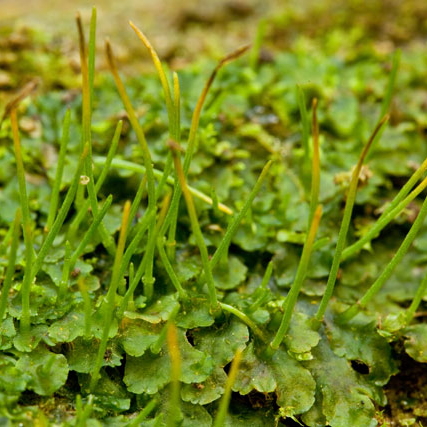Hornwort
 | |
| Kingdom: | Plantae |
|---|---|
| Phylum: | Anthocerotophyta |
| Clade: | Embryophytes |
| Division: | Anthocerotophyta |
| Source: Encyclopedia Britannica[1][4] | |
Description
Hornworts are small, non-vascular plants which belong to the division Anthocerotophyta. They are one of the oldest land plant lineages to exist today, dating back roughly 500 millions years ago. Hornworts are named for their horn-shaped sporophyte structures. Hornwarts exist in the same division as moss and liverwarts. They are unique from other brophytes due to their green, flat-bodied structures (thallus), during the gamete phase [3].
Characteristics
Hornworts have a flattened, thalloid gametophyte body, which has smooth rhizoid anchors to allow the plant to persist on many different surfaces, such as soil, rocks, and bark. They lack seeds, true roots, stems, and leaves, which characterises them as brophytes. They have an alternating life cycle with a haploid and diploid phase.The diploid sporophyte grows from the gametophyte and is characterized by an ascending horn-like structure. The gametophyte is characterized by a lobed or wrinkled, green colored sheet (thallus), which contains only 1-2 chloroplasts per cell, compared to liverworts and mosses which can have many chloroplast per cell. Hornworts produce mucilage cavities throughout every cell. There is no differentiation in the composition of the thallus of a hornwort, unlike the liverworts, which have different cells performing different functions within their thalli [2].
Habitat
Hornworts are found in many ecosystems around the world. They are most abundant in moist environments such as forests, wetlands, and along stream banks. However, some species can tolerate dry conditions such as deserts or tundras [4].
Life Cycle
The life cycle of hornworts follows an alternation of generations between haploid and diploid phases:
Gametophyte Phase: The dominant phase in the life cycle of hornworts is the gametophyte. It is a thalloid structure that carries out photosynthesis and produces sex organs.
Sporophyte Phase: The sporophyte phase begins when the female sex organ (archegonium) is fertilized by the sperm produced by the male sex organ (antheridium). This is done when the biflagellate sperm swims to the egg cell, fusing into a zygote. The fertilized egg develops into a sporophyte, which is the horn-like structure that emerges from the gametophyte. The sporophyte produces spores through meiosis. The spores are released and under the right conditions will produce more gametophytes [6].
Classification and Phylogeny
Hornworts belong to the division Anthocerotophyta, which is one of the three divisions of non-vascular land plants. They are further described by their families and genera based on their morphological and molecular properties. There are currently about 200 known species of hornworts. There are constantly new discoveries, as this particular plant is understudied [2].
Evolution
Hornworts are theorized to be one of the earliest groups of evolved land plants. They are suggested to have descended from algae species, roughly 500 million years ago. They have characteristics that suggest they evolved in primitive conditions, such as the lack of vascular tissues. Understanding the evolution of hornworts has played a significant role in the understanding of the colonization of land by plants. It is suggested that this is an early predecessor of vascular land plants, and branched off very early in the evolution of plants [3].
Uses
Hornworts have been used in traditional medicine for skin irritation, antibiotics, and wound healing. There has even been research done on their possible anti-cancerous properties. They also have ecological significance, contributing to soil formation and nutrient cycling. In scientific research, hornworts are used as model organisms to research properties of plant biology, and evolution, as they have remained almost entirely unevolved for 500 million years [5].
Work Cited
[1] "Hornwart" Encyclopedia Britannica, https://www.britannica.com/plant/hornwort
[2] “What is a hornwart?” Australian Bryophytes, https://www.anbg.gov.au/bryophyte/what-is-hornwort.html
[3] Eftychios Frangedakis, Masaki Shimamura, Juan Carlos Villarreal, Fay-Wei Li, Marta Tomaselli, Manuel Waller, Keiko Sakakibara, Karen S. Renzaglia, Péter Szövényi. “The hornwarts: morphology, evolution, and development.” New Phytologist, Vol 229, Issue 2, 13 August 2020, doi: 10.1111/nph.16874
[4] "Hornwarts" Australian Bryophytes, https://www.anbg.gov.au/bryophyte/classification-hornworts.html
[5]"Brophytes: Hoard of remedies, and ethno-medicinal review." Journal of Traditional and Complementary Medicine, 4 April 2016, doi: 10.1016/j.jtcme.2016.01.007
[6]"Reproduction and Dispersal" Australian Bryophytes, https://www.anbg.gov.au/bryophyte/reproduction-dispersal.html